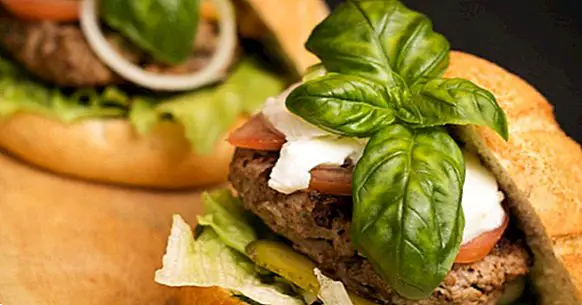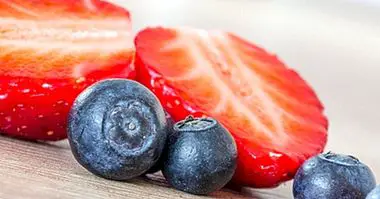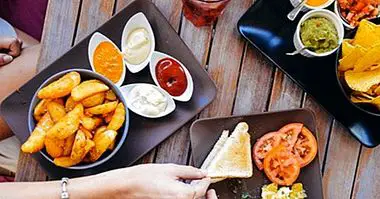The 12 types of nutrition and their characteristics
For humans, nutrition is the process by which the organism take advantage of nutrients from food so that your body and cells stay alive and have energy. However, not only do humans need to nourish themselves, but, for example, plants do too.
Evolutively there is no single way to extract from raw food the raw material of what needs to be built; It is a complex process that has been modified over several million years of evolution. These processes may be different and, therefore, can be classified in different ways in types of nutrition .
Nutrition is a vital process
The intake of food by humans is a vital need for the body. Good nutrition, that is, an adequate and well-balanced diet is necessary for good health and to avoid physical and mental deterioration.
This process brings the energy needed to keep us alive and it allows us to carry out all the other functions of living beings. Food also provides the raw materials for the growth and repair of our organism.
Difference between nutrition, diet and diet
There is some confusion with the term nutrition. As a science, it includes the study of foods and the processes involved using their nutrients: digestion, absorption and their assimilation in body cells . Nutrition, in fact, is an involuntary process, since it is too important to leave us at your command: the physiological functioning of the body takes care of it.
Thus, it would be wrong to talk about good nutrition or poor nutrition, because this would refer to food. Food is a series of voluntary and conscious actions that are directed to select, prepare and eat food . It is also often confused diet with food. Instead, diet is the eating habits of a person. Although this is associated with weight loss and control, the diet does not have to have any objective effect on body image.
- Related article: "The 4 types of healthy diets to be in top shape"
Types of nutrition
But… What types of nutrition are there? In the following lines you can find a classification of the different types of nutrition
1. Autotrophic nutrition
Autotrophic nutrition refers to feeding oneself, synthesizing organic substances. In other words, it's nutrition carried out by those living beings who are capable of producing their own food .
The plants are a clear example, because they feed thanks to photosynthesis. The living beings that carry out the process of photosynthesis are called photolitoautotrophs. On the other hand, those that use chemical elements are chemolithotrophs. For example: bacteria.
2. Heterotrophic nutrition
This type of nutrition is used by living beings who need an already prepared source of food. For example: animals, fungi and most microorganisms. Heterotropic nutrition It can be divided into several types :
Parasitic nutrition, in which the living being inhabits on or within another organism which it harms and from which it obtains its nutrients by ingestion or by absorption; saprophyte nutrition, in which the living being absorbs the nutrients from the environment and decomposes them through enzymes to obtain the energy it needs; and the holozoic, which is typical of humans, and in which an organism ingests food in a solid form and then digests it to obtain the nutrients it needs.
Holozoic nutrition can be classified in three ways :
- Herbivorous nutrition: The organism feeds on vegetables
- Carnivorous nutrition: The organism feeds on meat.
- Omnivorous nutrition: The organism feeds on vegetables and meat.
Types of nutrients
Nutrients are necessary for the growth and health of the organism. There are five types of nutrients that They are divided into two large groups: macronutrients and micronutrients . Macronutrients are needed in large quantities and include carbohydrates, proteins and fats. In contrast, micronutrients are needed in small amounts and include vitamins and minerals. Water and fiber are not nutrients but are necessary for the proper functioning of the body.
Below you can find the different types of nutrients.
1. Carbohydrates
Although carbohydrates have become the enemies of diet to lose weight, they are essential macronutrients for the organism, since they feed the brain and muscles. Carbohydrates they are the best source of energy and the foods that contain them can also be rich in fiber, which is necessary for the intestine to function properly.
There are two types: simple carbohydrates (banana, honey, etc.), which contain one or two sugars; and complex carbohydrates (for example, brown rice) that are made from three or more linked sugars. These macronutrients provide 4 calories per gram, although complexes take longer to digest than simple carbohydrates and are more satiating.
- Related article: "The 16 most satiating and ideal foods to lose weight"
2. Proteins
Proteins are the nutrients structural to all cells . That is, they form what we could call the raw material of our body, the bricks with which it is built and reformed. On the other hand, they also help repair tissue and fight infections. When consumption exceeds the body's needs, protein can serve as a source of energy. They provide 4 calories per gram.
- Related article: "The 20 types of proteins and their functions in the body"
3. Fats
Fats, like the two previous macronutrients, also provide energy to the body and participate in the processes that keep the body alive. But nevertheless, provide 9 calories per gram . Although they are currently demonized, fats are essential to stay in good health.
On the other hand, fats have other functions besides energy. For example, they fulfill a structural role, offer a means of transport for certain substances, and increase palatability.
There are several types of fat, you can know more in this article: "Types of fats (good and bad) and their functions".
4. Vitamins
The vitamins are micronutrients that the body needs to assimilate other nutrients. Its functions are: participate in the formation of chemicals in the nervous system, red blood cells, hormones and genetic material. Likewise, metabolic systems participate in the regulation and are necessary for the health and good functioning of the organism.
If you want to know the different types of proteins, in this article you can delve into this topic: "Types of vitamins: functions and benefits for your body."
5. Minerals
The minerals They give structure to bones, teeth and nails . Like vitamins, they help enzymes in many body processes. Now, unlike these, are inorganic substances that come from soil, rocks and water. Calcium, phosphorus, potassium, zinc or magnesium are some examples of minerals.
Types of food
As commented in the previous lines, the feeding is a series of voluntary actions that are directed to select what is swallowed. The types of food that exist are the following.
1. Veganism
Veganism is the behavior of an individual who decides do not eat food products of animal origin nor, in general, use any product that to be produced involves the death of animals. Therefore, a vegan does not eat meat and fish products, nor do they consume eggs, dairy products or honey.
In addition, in certain cases, products known to be condemning animals to death due to their production system are not consumed, even though they are of purely vegetable origin.
2. Vegetarianism
Vegetarians are people who basically eat vegetables because of their ideology. Apart from strict vegetarians, there are also lacto-ovo vegetarians , who eat eggs and dairy products in addition to vegetables, and lacto-vegetarians, who only incorporate dairy products in their diet as well as vegetables. The idea is not to consume animals directly, but some of the products derived from their way of life.
3. Emotional feeding
It is the food that It is associated with emotional and psychological problems . For example, when someone suffers anxiety, they consume more fat-rich foods, even automatically and without realizing it.
4. Sports nutrition
It is the food that pretends increase sports or physical performance . For example, the consumption of carbohydrates to perform better in a marathon. It is also associated with the improvement of physical appearance and bodybuilding.
5. Healthy eating
Healthy eating is the choice to consume products that are beneficial for well-being . For example, fruit or olive oil for its healthful properties.



















